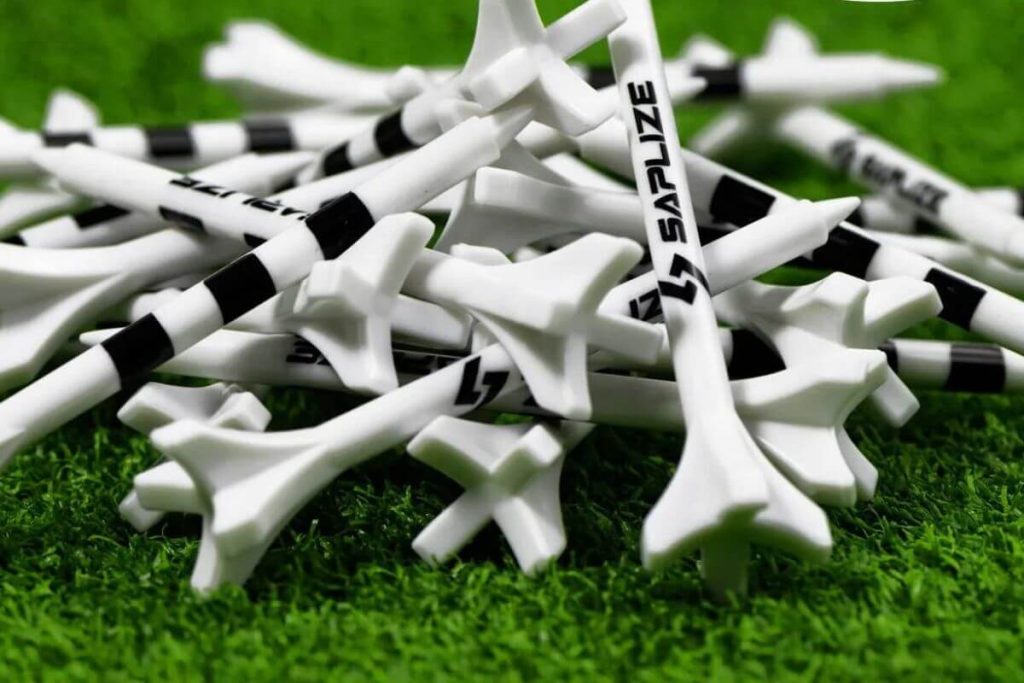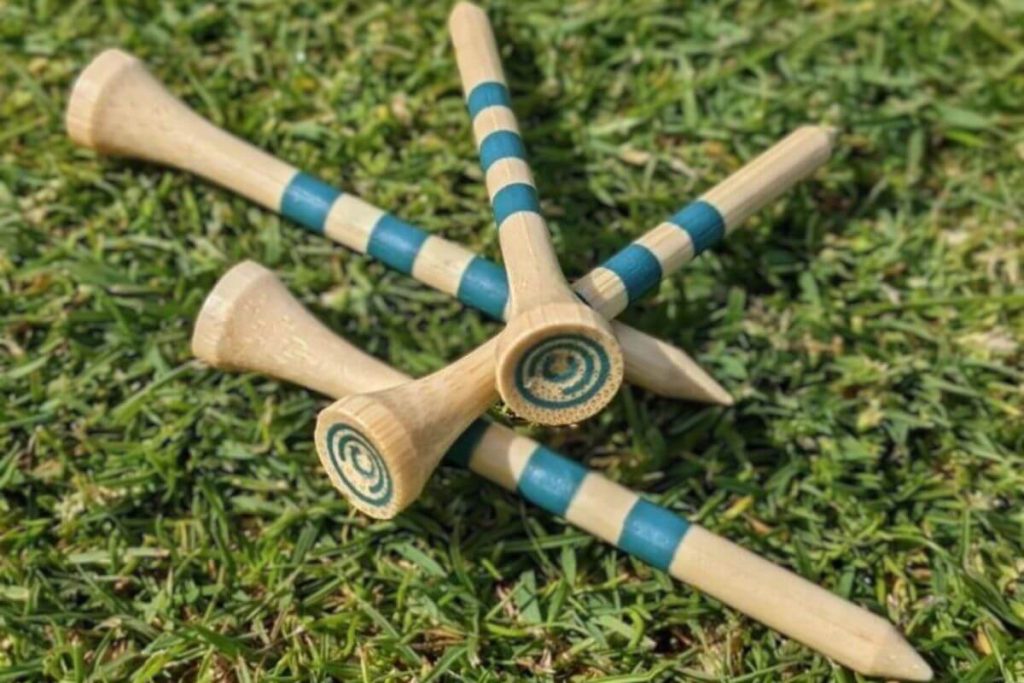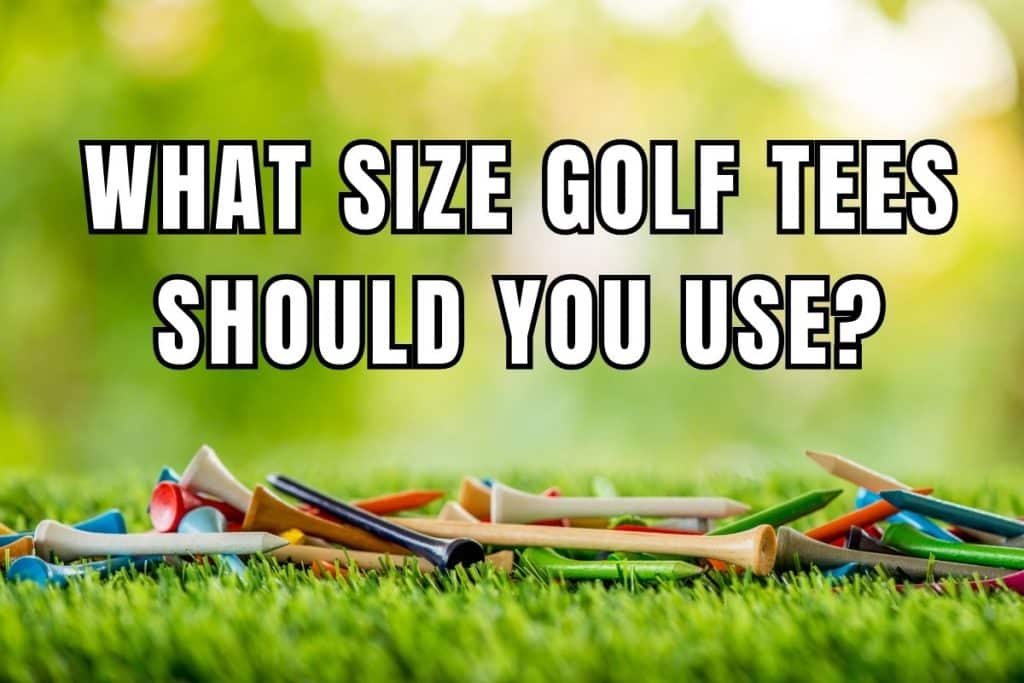Choosing the right size golf tee can be an important aspect of your golf game, as it can affect your shot’s height, distance, and accuracy.
Golf tees come in various sizes, such as 1.5 inches, 2 inches, 2.75 inches, 3.25 inches, and 4 inches.
The ideal tee size depends on your club type, playing style, and personal preferences.
Understanding the different tee sizes and how they work with specific clubs is critical to making an informed decision on what to buy and use. For example, 3.25-inch and 4-inch tees are often ideal for drivers, as they allow for higher ball placement, while shorter tees may be better suited for shorter holes.
Trying out different tee sizes and practicing with them can help you find the best match for your needs and improve your overall performance on the course.
Table of contents
Understanding golf tees
Types of golf tees
I often experiment with different golf tee sizes to find the most suitable one for my game or tweak certain issues or problems I am facing with my contact or ball flight trajectory.
Thankfully, there are many tee sizes available to suit various preferences and needs.
The most common tee sizes include 2.75 inches, 3.25 inches, and 4 inches.
Smaller tees, such as 1.5 inches and 2 1/8 inches, are also available for those who prefer teeing the ball just above the grass.
When selecting the appropriate tee size, factors like the club I’m using and my playing style impact the decision.
For instance, smaller tees are ideal for fairway woods, hybrids, and irons, while 3.25-inch and 4-inch tees are great for drivers.
Having said that, the all time great himself, Tiger Woods, actually prefers hitting drive from a shorter tee, so there is no one method to playing good golf when it comes to tee height.
Tee materials and design
Golf tees come in various materials and designs.
Traditionally, wooden tees were the standard; however, we now have tees made from plastic and biodegradable materials, too.
Each material offers its own set of advantages and disadvantages.
For example, wooden tees have a classic look and feel, but they can break easily.
On the other hand, plastic tees are more durable but may cause damage to mowers if left on the course, and, overall, are worse for the environment.
Additionally, tee designs have evolved to provide golfers with more options and promote better performance.
Some tees now feature two or more prongs at the top, which can reduce friction between the ball and tee, resulting in longer drives through the conservation of energy.
There are also tees with a marked band to help golfers achieve consistent tee height during their play.

Such designs can assist players in creating more repeatable contact.
How tee length affects shots
Ball flight and spin
When considering which golf tee length to use, you have to understand how the tee height can impact the ball’s flight and spin. Based on various golf tee lengths, we can deduce that longer tees typically produce higher ball flights with more distance.
For instance, using a 2.75-inch tee or a 3.25-inch tee may result in a higher trajectory, generally improving height and distance.
Contrarily, shorter tees, like 1.5 inches or 2 1/8 inches, are better suited for iron shots, as they don’t elevate the ball as much as their longer counterparts.
Influence on swing style
Tee length can also affect your swing style.
Golfers with a steep or aggressive swing may benefit from using a shorter tee, while those with a shallow swing could perform better with a longer one.
Personal preference plays a significant role in determining the appropriate tee length for your swing style.
A 4-inch tee may provide more room for error and allow for an upward driver swing, maximizing distance, while a 2.75-inch or 3.25-inch tee might be more suitable for players who want a more controlled shot.
Like the unwritten rules of links golf dictate, often keeping the ball as low to the ground as possible is the best method to reducing your score and staying out of trouble.
Ultimately, it’s essential to experiment with different tee heights to find the one that best suits your game.
How tee size reflects on club type
When it comes to golf, selecting the appropriate tee size is crucial to achieving optimal results with each club in your bag.
As such, tee size is influenced by the type of club being used: drivers, irons, hybrids, and fairway woods.
Tees for drivers
Utilizing the correct tee size for your driver is essential for achieving maximum distance and accuracy.
Generally, I recommend using 3.25 and 4 inch tees for optimal driver performance.
Tee height influences ball flight, and a taller tee allows for better contact with the clubhead’s sweet spot with a wider window created for flush contact.
Make sure at least half of the golf ball is above the clubhead when teeing up for a driver shot to promote optimal path and angle of attack.
Tees for irons
For irons, shorter tees are preferable.
1.5 and 2 ⅛ inch tees are suitable choices, as they keep the ball closer to the ground and allow for better contact with the clubface.
This tee height aids in achieving the desired trajectory and spin necessary for iron shots, causing you still to hit down on the ball and allow the loft to do the work, imparting backspin on the ball.
Be sure to practice adjusting your swing to accommodate different iron lengths, as long irons, although still needing a downward swing, can be shallower at impact and allow for a slightly higher tee.
Tees for hybrids
Hybrids are versatile clubs that combine characteristics of both irons and fairway woods.
When choosing a tee for a hybrid club, you may opt for the smallest tees, which are between 1.5 and 2 ⅛ inches in length.
These tees place the ball just above the grass, allowing for smooth contact with the hybrid’s clubhead.
Try and avoid the temptation to tee the ball up too high with a hybrid, as many golfers will be lured into hitting up on hybrids shots – something they are very much not designed for.
Tees for fairway woods
Teeing up for fairway woods can be similar to hybrids, as they both require a low tee height for optimal performance.
1.5 to 2 ⅛ inch tees are recommended for fairway woods.
This tee height positions the ball at the optimal height to ensure maximum distance and accuracy, while also minimizing the risk of pop-ups or skying the ball, something many players will see if tempted to tee the ball too high and ‘hit up’.
Be mindful of your swing mechanics when using fairway woods, as adjustments may be necessary in comparison to driver or iron shots.
Specifically designed tees
Brush tees
Brush tees are designed with nylon bristles on top, which are meant to reduce the resistance on the clubface when striking the ball.
This not only helps provide a more accurate shot, but it also claims to increase the distance the ball travels.
I personally find the brush tees a little off-putting when compared to the more traditional look, but if struggling for distance, might be worth a try yourself.
Zero friction tees
As I explored different tee options, I came across zero friction tees.
These unique tees have a three-pronged design that minimizes the contact between the tee and the ball, thus reducing drag and promoting greater distance on drives.
I’ve tested them myself and did find them pretty durable, but I don’t know if they provide the extra distance they claim.
Anti-slice tees
Another type of tee that I have experimented with is the anti-slice tee (like these from RecTeeFier).
These tees are designed with an angled base that encourages a square clubface at impact, thus reducing the likelihood of slicing the ball.
As someone who occasionally battles with slicing, I appreciate the concept behind these tees, but didn’t really find them to be an overwhelming solution for my slicing woes.
Ultimately, I can only encourage you to experiment with these options and see which one suits your playing style best.
Environmental sustainability and golf tees
Plastic vs wood vs bamboo
When it comes to golf tees, there are various materials available such as wood, plastic, and bamboo.
Each has its own advantages and disadvantages, but in terms of environmental sustainability, some are better than others.
I do see importance in the environmental impact of my choices on the course, and that includes selecting the right golf tees.
Wooden tees are a popular choice among golfers due to their cheaper price and traditional feel.
Along with this, they are generally quite biodegradable, unlike plastic tees.
Even so, bamboo tees (like these ones from MAZEL) are a more sustainable option than the traditional wooden tees.
Bamboo is a renewable resource that grows quickly and requires little water or attention to thrive.

It also provides impressive strength, making these tees more durable than their wooden counterparts.
Bamboo tees decompose more quickly than plastic tees when discarded, reducing the impact on landfills and the environment overall.
In contrast, plastic tees are known for their durability, but they can be quite problematic in terms of environmental sustainability.
Many plastic tees are made from non-biodegradable materials that can pollute the soil, waterways, and wildlife habitats.
Although there are some eco-friendly plastic tees made of biodegradable materials, they still take a long time to break down compared to bamboo tees.
As an environmentally conscious golfer, I recommend using bamboo tees whenever possible to minimize the environmental footprint of your golf game, and failing that, wooden tees.
By making this simple switch, you can feel confident that you’re doing your part to protect the planet while still enjoying the sport you love.
Frequently Asked Questions (FAQs)
What is the optimal tee height for drivers?
Generally, the optimal tee height for drivers is achieved when at least half the golf ball is above the clubhead.
This allows for an upward strike, producing more distance and height.
Tee heights may vary depending on personal preference and swing style, but using a 3.25-inch or 4-inch tee is generally recommended for drivers.
Which tee size is suitable for irons?
For irons, I recommend using the smaller golf tees, such as the 1.5-inch or 2.1-inch tees.
These shorter tees are ideal for providing a stable foundation when hitting the ball with fairway woods, hybrids, and irons, and promoting a negative angle of attack.
Are longer golf tees better for beginners?
Longer golf tees can be beneficial for beginners as they allow them to strike the ball on an upward trajectory and offer more overall forgiveness.
However, other than driver, striking up on the ball isn’t ideal, so this should only be used as a short term aid while new to the game.
I would suggest that beginners try different tee lengths to find the one that best suits their swing and provides the most consistent results.
What is the difference between standard and oversized golf tees?
Standard golf tees typically range from 1.5 to 4 inches in length, while oversized tees can be longer than 4 inches.
These oversized tees are designed to accommodate larger clubheads, such as modern drivers, offering greater stability and additional height for the ball.
However, it’s important to note that the increased height might not be suitable for all golfers, as it can affect the swing path and contact with the golf ball.
Finding the right tee size that works for your swing style and club selection is crucial for consistent performance on the course.
Final message
While there are many tee options out there on the market – ranging from anti-slice to environmentally sustainable – the only way to truly understand what works for you is to try a few styles.
Once you settle on something, consistency is key, and by using the same tees at the same height for certain clubs, you’ll remove another variable from your game that might be leading to your woes.

